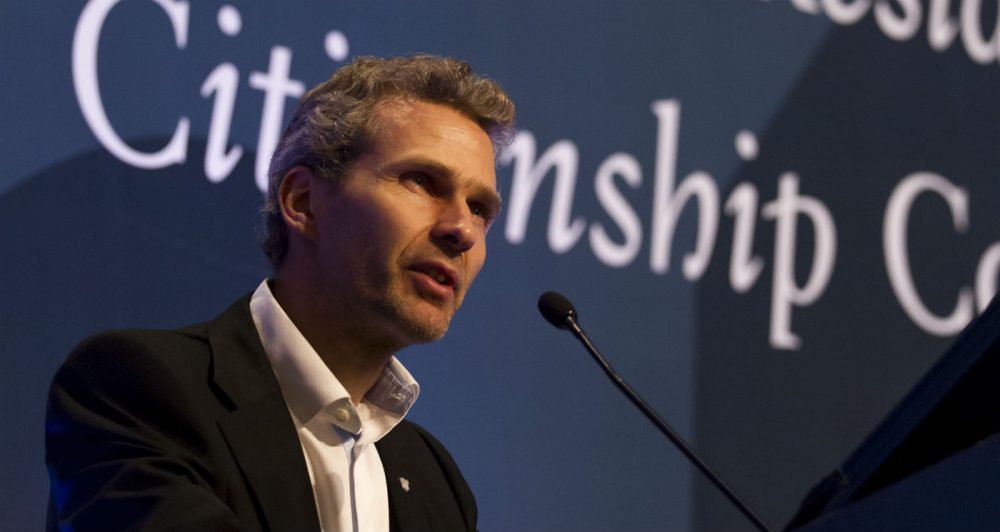by Dr. Christian H. Kälin
IMC Forum, 4–6 June 2018
I have been tasked today with looking ahead to 2020 and sharing my vision for where we, as an industry, are heading. I do not have a crystal ball, but I do have the track record of our astonishing progress over the years, which gives me a sense of our future direction.
A few observations about investment migration now seem undeniable.
- First, we are seeing unprecedented growth on both the demand and the supply side.
- Second, residence- and citizenship- by-investment have become fully mainstreamed and are no longer niche or fringe phenomena.
- Third, the concept of global citizenship has become the new cultural norm. And finally — and most significantly — investment migration is here to stay. I do not think anyone would disagree with these statements, not even our most ardent critics.
In fact, it seems clear to me that we are coming under increased scrutiny globally precisely because our growth has become unstoppable. As we become highly relevant, more visible, and permanently entrenched in the economic landscape, it is only inevitable that we should encounter resistance, skepticism, and in many cases sheer confusion from those on the outside.
But rather than a weakness, I think these external challenges should be viewed as a testament to our very strength. Indeed, when I look back at all we have achieved so far, I am left with the unshakeable conviction that our greatest triumphs are still ahead of us. It is my intention in this address today to sketch out some of the steps that need to be taken in order for us to get there.
Evolving models of citizenship
Let us begin by reflecting on current conceptions of citizenship and the impact they are having on the future direction of investment migration. It cannot be denied that the industry is undergoing rapid expansion, and it is my view that this unprecedented growth correlates with the emergence of a much more open and progressive vision of the meaning of citizenship.
Moreover, I anticipate that the concept of residence- and citizenship-by-investment is going to become even more accepted globally. The evolution of citizenship from a matter of accident to a matter of choice is, I think, inevitable, and our freedom to choose our citizenship will soon become a simple fact of modern life — no more or less remarkable than our freedom to choose our career, our partner, our religion, and so on.
This sentiment may come as a surprise, given the seemingly growing trend towards nationalism, populism, and highly politicized understandings of identity and belonging, both here in Europe and elsewhere. There is no denying that attempts to reinforce national borders and reassert ‘us versus them’ thinking are on the rise, but it is important to see these developments as a backlash against a major historical shift towards globalism — towards the free movement of labor, goods, services, capital, people, and ideas across borders and continents.
This historical shift that we are undergoing is much more powerful and unstoppable than its temporary counter-movement. With the predominance of the internet and the current structure of the world economy, I do not think there is any chance of turning back the tide of globalization and reverting to a world made up of isolated nation-states.
The reality is that the majority of people living in the modern world view citizenship in simple, non-political terms. They are mothers, fathers, sons, and daughters with very concrete plans and dreams for themselves and their families. They want to build the best possible life they can, and they are much more aware than their predecessors were of the vast opportunities and possibilities available in the wider world.
As such, people today tend to think of their citizenship as a give-and-take equation: what am I giving to the state (in the form of taxes, duties, and so on) and what am I getting back from the state (in the form of social security, public services, and so on). If people do the calculation and find that they are giving more than they are getting, that their nationality is hurting rather than helping their progress, they may begin to consider their options.
For those on the lower end of the economic spectrum, this may mean economic migration, through either legal or so-called ‘illegal’ means. For those on the upper end, investment migration can be a life-changing solution. What I am trying to suggest here is that the apolitical and more rational view of citizenship that has emerged with globalization lends itself quite strongly to the vision of global citizenship that I think all of us in this sector share. I believe that this trend will be solidified with each passing year, which will further normalize the logic behind residence- and citizenship- by-investment programs.
Future program and industry trends
So far we have mainly been discussing investment migration from the individual’s perspective. But governments of course also stand to gain from evolving conceptions of citizenship. If citizenship and residence are things that can be actively selected rather than merely passively received, then governments have the opportunity to attract highly qualified and talented individuals to join their pool of citizens or residents, in turn boosting the flow of talent and capital into their countries.
Recent data out of Malta speaks to the profound impact that a successful program can have on a country’s fiscal health: for 2017, Malta reported a budget surplus amounting to 3.9% of total GDP, which is higher than any other EU member country and the fourth highest percentage of any country in the world. Crucially, the capital raised through the country’s Individual Investor Program in 2017 accounted for 90% of this surplus. IMalta’s citizenship-by-investment program has effectively reversed a deficit trend that has been in place for as long as statistics have been publicly available.
As the economic benefits of residence- and citizenship-by-investment become increasingly evident, more countries are looking to leverage this vital mechanism for stimulating competitiveness and growth. We are already seeing a significant number of high-profile countries seeking to enter the space. And as the public becomes more educated and models of global citizenship become more accepted, there is no doubt that governments will be further incentivized to explore the adoption of investment migration programs. Overall, by 2020, I expect that the number of truly relevant and successful programs will grow from the current total of about 30 to perhaps as many as 40 or 50.
This raises a question about the intermediary, advisory, and agent landscape. Will this segment of the industry expand in proportion to the number of programs, or will we begin to see greater consolidation emerging in the near future? This segment, as I am sure you are aware, is already rather vast, which is typical of an industry coming out of a strong ‘growth’ phase in its lifecycle.
Our research has shown that there are some 550 companies registered with various authorities around the world that are servicing the investment migration industry. And this number is in fact only a fraction of the total market size: if you factor in the companies that do marketing and promotional work in outbound countries, the number becomes much bigger. Both small start-ups and larger firms from adjacent industries such as accounting and legal services have entered the investment migration market in recent years, and they will in all likelihood continue to do so as demand and supply pick up. At present, the entry rate is much higher than both the exit rate and the consolidation rate, which has resulted in significant fragmentation within the industry.
On the one hand, the high rate of entry is a positive thing: more reputable, heavyweight firms are joining the industry, which increases its seriousness and credibility. On the other hand, the entry rate is so high precisely because the barriers to entry are so low. As a result, we currently have the full spectrum of firms active in the space, ranging from the highly reputable to the highly dubious. What we want to see going forward is, first, larger firms with strong track records and expertise securing market share and, second, the requirements for younger, more opportunistic firms becoming much more stringent.
The shifting regulatory landscape
Which brings me to my final point: the evolving regulatory landscape. There is no question that we are going to see greater regulation of the investment migration industry in the years to come. The level of self-regulation that has already taken place is significant for an emerging industry such as ours and is to be applauded, but I think we are set to see regulation becoming one of the major focuses going forward.
Of course, there are two main ‘sites’ of regulation: namely, the regulation enforced by inbound countries, where applications for citizenship or residence are received, and the regulation enforced by outbound countries, where citizenship or residence programs are marketed.
In terms of inbound regulation, governments typically have a list of local agents approved for processing applications who need to have very specific legal or other qualifications in place. Then they have a list of approved marketing agents, who likewise need to meet certain professional standards. In terms of outbound regulation, however, things tend to get a murkier, with many unapproved and unregulated agents aggressively promoting programs in target countries, sometimes in dishonest or misleading ways.
Inbound governments have little control over these activities, since they are taking place in other jurisdictions. Outbound governments, meanwhile, may not wish to enforce regulation in their region — after all, they are not exactly wanting to encourage their citizens to migrate or invest elsewhere, so they may think it is in their best interests for the investment migration industry to remain disorganized. On the other hand, there are countries such as China that do enforce regulation for investment migration marketers, but these rules are often simply ignored by agents on the ground. So the outbound situation is somewhat complex, and the regulation trajectory over the next few years will be far from straightforward in this space. This is a major challenge that industry stakeholders need to address.
The inbound regulation story is much more promising. The standards implemented by program countries have been rising steadily, especially since Malta changed the game with its Individual Investor Program in 2014. Today, the due diligence mechanisms enforced by the Maltese government during its application processing are the highest in the industry and have been widely lauded as the ‘gold standard’ for investment migration. I expect that, in five years’ time, this gold standard will simply have become the norm across the board.
I make this prediction for several reasons. Perhaps most importantly, the industry is coming under increasing pressure from supranational entities such as the OECD to step-up regulation efforts. Based on the recent advocacy activity surrounding the Common Reporting Standard, it seems likely that a set of recommendations will be issued by the OECD in the next year. These recommendations will see governments adjusting their due diligence processes accordingly, in order to remain relevant and competitive.
Regulation is something to be embraced, since a cleaner industry benefits us all. It builds trust and confidence with major partners, especially with financial institutions, and it will serve to make all our operations much smoother and more secure over the long term.
Overall, the industry is on a strong and healthy path forward. Further growth, consolidation, and regulation are inevitable and will without a doubt pave the way for greater sustainability. I encourage all stakeholders to continue developing their advocacy, thought leadership, media engagement, and due diligence efforts, since building credibility will be essential for expanding the remarkable successes we have already collectively achieved.
Conclusion
Our tireless belief in the potential of investment migration has gotten us to where we are today, pioneers of an industry that is pushing the boundaries of citizenship, governance, and personal freedom. We have taken the road less traveled, and that, indeed, has made all the difference. Thank you.
Dr. Christian H. Kälin, TEP, IMCM, Chairman of Henley & Partners, is considered one of the world’s foremost experts in investment migration and citizenship-by-investment, a field he pioneered. Holding master’s and PhD degrees in law from the University of Zurich, he is a sought-after speaker and advises governments and international organizations. He is the author, co-author, or editor of many publications, including standard works such as the Global Residence and Citizenship Handbook, Ius Doni: The Acquisition of Citizenship by Investment, the Henley & Partners – Kochenov Quality of Nationality Index, and the Switzerland Business & Investment Handbook.





